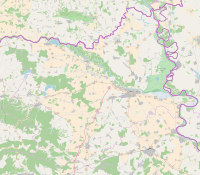Church of St. Demetrius, Dalj
| Church of St. Demetrius | |
|---|---|
| Crkva svetog Dimitrija Црква светог Димитрија |
|

Church of St. Demetrius
|
|
| 45°29′02″N 18°59′13″E / 45.4840°N 18.9870°ECoordinates: 45°29′02″N 18°59′13″E / 45.4840°N 18.9870°E | |
| Location | Dalj, Osijek-Baranja County |
| Country |
|
| Denomination | Serbian Orthodox |
| History | |
| Dedication | Demetrius of Thessaloniki |
| Architecture | |
| Status | Church |
| Functional status | Active |
| Style | Baroque |
| Specifications | |
| Height | 50 m |
| Floor area | 576 m2 |
| Administration | |
| Archdiocese | Eparchy of Osječko polje and Baranja |
The Church of St. Demetrius (Croatian: Crkva svetog Dimitrija, Serbian Cyrillic: Црква светог Димитрија) in Dalj is a Serbian Orthodox church in Dalj in eastern Croatia, the cathedral of the Eparchy of Osječko polje and Baranja. The first church on this site was built in 1715, and the present-day church was built in 1799. Church of St. Demetrius is the largest cathedral of the Serbian Orthodox Church in Croatia.
Church is dedicated and named after Demetrius of Thessaloniki, Christian martyr, who lived in the early 4th century. During the Middle Ages, he came to be revered as one of the most important Orthodox military saints, often paired with Saint George. His feast day is 26 October for Christians following the Gregorian calendar and 8 November for Christians following the Julian calendar.
The height of church bell tower is 50 metres, church width is 16 metres and length 36 metres.
On the site of present-day church, which was built in 1799, stood an older wooden church which is often case with Orthodox churches in eastern Croatia. At the site of wooden church in 1715 was built first church made of solid material. Construction of current church began in 1791.
Church iconostasis was completed in 1824. Church was consecrated in 1840. The church has been renovated in its history several times, in 1837, 1866, 1901, 1931, 1949 and 2004.
The church was badly damaged during World War II by decision of Ustaše authorities of Independent State of Croatia. The church was closed on 12 July 1941. Then the church bells were removed, iconostasis was demolished (although most of the icons survived), the tiles were removed, the tower dynamited and parts of the church walls were destroyed.
...
Wikipedia

